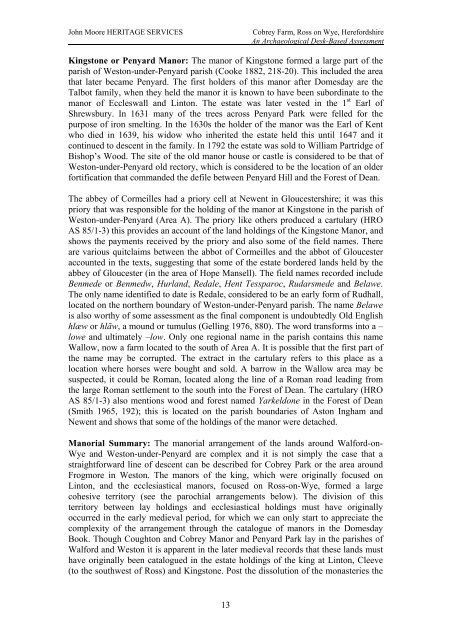JOHN MOOREHERITAGE SERVICES - Archaeology Data Service
JOHN MOOREHERITAGE SERVICES - Archaeology Data Service
JOHN MOOREHERITAGE SERVICES - Archaeology Data Service
Create successful ePaper yourself
Turn your PDF publications into a flip-book with our unique Google optimized e-Paper software.
John Moore HERITAGE <strong>SERVICES</strong> Cobrey Farm, Ross on Wye, Herefordshire<br />
An Archaeological Desk-Based Assessment<br />
The manor of Kingstone formed a large part of the<br />
parish of Weston-under-Penyard parish (Cooke 1882, 218-20). This included the area<br />
that later became Penyard. The first holders of this manor after Domesday are the<br />
Talbot family, when they held the manor it is known to have been subordinate to the<br />
manor of Eccleswall and Linton. The estate was later vested in the 1 st Earl of<br />
Shrewsbury. In 1631 many of the trees across Penyard Park were felled for the<br />
purpose of iron smelting. In the 1630s the holder of the manor was the Earl of Kent<br />
who died in 1639, his widow who inherited the estate held this until 1647 and it<br />
continued to descent in the family. In 1792 the estate was sold to William Partridge of<br />
Bishop’s Wood. The site of the old manor house or castle is considered to be that of<br />
Weston-under-Penyard old rectory, which is considered to be the location of an older<br />
fortification that commanded the defile between Penyard Hill and the Forest of Dean.<br />
The abbey of Cormeilles had a priory cell at Newent in Gloucestershire; it was this<br />
priory that was responsible for the holding of the manor at Kingstone in the parish of<br />
Weston-under-Penyard (Area A). The priory like others produced a cartulary (HRO<br />
AS 85/1-3) this provides an account of the land holdings of the Kingstone Manor, and<br />
shows the payments received by the priory and also some of the field names. There<br />
are various quitclaims between the abbot of Cormeilles and the abbot of Gloucester<br />
accounted in the texts, suggesting that some of the estate bordered lands held by the<br />
abbey of Gloucester (in the area of Hope Mansell). The field names recorded include<br />
Benmede or Benmedw, Hurland, Redale, Hent Tessparoc, Rudarsmede and Belawe.<br />
The only name identified to date is Redale, considered to be an early form of Rudhall,<br />
located on the northern boundary of Weston-under-Penyard parish. The name Belawe<br />
is also worthy of some assessment as the final component is undoubtedly Old English<br />
hlæw or hlāw, a mound or tumulus (Gelling 1976, 880). The word transforms into a –<br />
lowe and ultimately –low. Only one regional name in the parish contains this name<br />
Wallow, now a farm located to the south of Area A. It is possible that the first part of<br />
the name may be corrupted. The extract in the cartulary refers to this place as a<br />
location where horses were bought and sold. A barrow in the Wallow area may be<br />
suspected, it could be Roman, located along the line of a Roman road leading from<br />
the large Roman settlement to the south into the Forest of Dean. The cartulary (HRO<br />
AS 85/1-3) also mentions wood and forest named Yarkeldone in the Forest of Dean<br />
(Smith 1965, 192); this is located on the parish boundaries of Aston Ingham and<br />
Newent and shows that some of the holdings of the manor were detached.<br />
The manorial arrangement of the lands around Walford-on-<br />
Wye and Weston-under-Penyard are complex and it is not simply the case that a<br />
straightforward line of descent can be described for Cobrey Park or the area around<br />
Frogmore in Weston. The manors of the king, which were originally focused on<br />
Linton, and the ecclesiastical manors, focused on Ross-on-Wye, formed a large<br />
cohesive territory (see the parochial arrangements below). The division of this<br />
territory between lay holdings and ecclesiastical holdings must have originally<br />
occurred in the early medieval period, for which we can only start to appreciate the<br />
complexity of the arrangement through the catalogue of manors in the Domesday<br />
Book. Though Coughton and Cobrey Manor and Penyard Park lay in the parishes of<br />
Walford and Weston it is apparent in the later medieval records that these lands must<br />
have originally been catalogued in the estate holdings of the king at Linton, Cleeve<br />
(to the southwest of Ross) and Kingstone. Post the dissolution of the monasteries the<br />
13

















